Transferrin-Bound Doxorubicin Enhances Apoptosis and DNA Damage through the Generation of Pro-Inflammatory Responses in Human Leukemia Cells
Abstract
1. Introduction
2. Results
2.1. Various Forms of Doxorubicin Exert Differential Cytotoxicity in Human Leukemia Cells
2.2. DOX–Tf Conjugate Generates the Accumulation of ɣH2AX Phosphorylation
2.3. Conjugate-Dependent DNA Damage/Lesions Are Connected to Apoptotic Cell Death
2.4. The Extrinsic TRAIL-Dependent Apoptotic Pathway Is Triggered by DOX–Tf Conjugate in Human Leukemia Cells
2.5. The Growth of TNF-α Expression Is Initiated by Tf-Bound DOX and Free Drug in Human Leukemia Cells
2.6. The Involvement of IL-6 and IL-4 Cytokines in DOX–Tf Cytotoxicity
3. Discussion
4. Materials and Methods
4.1. Reagents
4.2. Cell Culture
4.3. Cell Cytotoxicity Assay
4.4. H2AX Assay
4.5. TUNEL Assay
4.6. ELISA
4.7. Quantitative Real-Time RT-PCR
4.8. Statistical Analysis
Author Contributions
Funding
Acknowledgments
Conflicts of Interest
Abbreviations
| ALL | acute lymphoblastic leukemia |
| CML | chronic myelogenous leukemia |
| DOX | Doxorubicin |
| DOX–Tf | Doxorubicin–transferrin conjugate |
| FBS | Fetal bovine serum |
| HMBS | Hydroxymethylbilane synthase (HMBS) |
| HPRT1 | Hypoxanthine phosphoribosyltransferase 1 |
| IL-1 | interleukin-1 |
| TfR | Transferrin receptors |
| TNF-α | tumor necrosis factor-α |
| NF-κB | nuclear factor-κB |
| TRAIL | TNF-related apoptosis-inducing ligand |
| FADD | Fas-associated death domain-containing protein |
| DISC | death-inducing signaling complex |
References
- Dong, Y.; Shi, O.; Zeng, Q.; Lu, X.; Wang, W.; Li, Y.; Wang, Q. Leukemia incidence trends at the global, regional, and national level between 1990 and 2017. Exp. Hematol. Oncol. 2020, 9, 14. [Google Scholar] [CrossRef]
- Muselli, F.; Peyron, J.-F.; Mary, D. Druggable Biochemical Pathways and Potential Therapeutic Alternatives to Target Leukemic Stem Cells and Eliminate the Residual Disease in Chronic Myeloid Leukemia. Int. J. Mol. Sci. 2019, 20, 5616. [Google Scholar] [CrossRef] [PubMed]
- Green, S.D.; Konig, H. Treatment of Acute Myeloid Leukemia in the Era of Genomics—Achievements and Persisting Challenges. Front. Genet. 2020, 11, 480. [Google Scholar] [CrossRef] [PubMed]
- Loscocco, F.; Visani, G.; Galimberti, S.; Curti, A.; Isidori, A. BCR-ABL Independent Mechanisms of Resistance in Chronic Myeloid Leukemia. Front. Oncol. 2019, 9. [Google Scholar] [CrossRef] [PubMed]
- Phelan, K.W.; Advani, A.S. Novel Therapies in Acute Lymphoblastic Leukemia. Curr. Hematol. Malign Rep. 2018, 13, 289–299. [Google Scholar] [CrossRef]
- Imai, K. Acute lymphoblastic leukemia: Pathophysiology and current therapy. [Rinsho ketsueki] Jpn. J. Clin. Hematol. 2017, 58, 460–470. [Google Scholar]
- Sauter, K.A.D.; Wood, L.J.; Wong, J.; Iordanov, M.; Magun, B.E. Doxorubicin and daunorubicin induce processing and release of interleukin-1β through activation of the NLRP3 inflammasome. Cancer Biol. Ther. 2011, 11, 1008–1016. [Google Scholar] [CrossRef]
- Pai, V.B.; Nahata, M.C. Cardiotoxicity of chemotherapeutic agents: Incidence, treatment and prevention. Drug Saf. 2000, 22, 263–302. [Google Scholar] [CrossRef]
- Tien, C.-C.; Peng, Y.-C.; Yang, F.-L.; Subeq, Y.-M.; Lee, R.-P. Slow infusion rate of doxorubicin induces higher pro-inflammatory cytokine production. Regul. Toxicol. Pharmacol. 2016, 81, 69–76. [Google Scholar] [CrossRef]
- Kabel, A.M.; Alzahrani, A.A.; Bawazir, N.M.; Khawtani, R.O.; Arab, H.H. Targeting the proinflammatory cytokines, oxidative stress, apoptosis and TGF-β1/STAT-3 signaling by irbesartan to ameliorate doxorubicin-induced hepatotoxicity. J. Infect. Chemother. 2018, 24, 623–631. [Google Scholar] [CrossRef]
- Sala, V.; Della Sala, A.; Hirsch, E.; Ghigo, A. Signaling Pathways Underlying Anthracycline Cardiotoxicity. Antioxid. Redox Signal. 2020, 32, 1098–1114. [Google Scholar] [CrossRef]
- Singla, D.K.; Johnson, T.A.; Dargani, Z.T. Exosome Treatment Enhances Anti-Inflammatory M2 Macrophages and Reduces Inflammation-Induced Pyroptosis in Doxorubicin-Induced Cardiomyopathy. Cells 2019, 8, 1224. [Google Scholar] [CrossRef] [PubMed]
- Dargani, Z.T.; Singla, D.K. Embryonic stem cell-derived exosomes inhibit doxorubicin-induced TLR4-NLRP3-mediated cell death-pyroptosis. Am. J. Physiol. Circ. Physiol. 2019, 317, H460–H471. [Google Scholar] [CrossRef] [PubMed]
- Xu, L.; Hu, X.; Qu, X.; Hou, K.; Zheng, H.; Liu, Y. Cetuximab enhances TRAIL-induced gastric cancer cell apoptosis by promoting DISC formation in lipid rafts. Biochem. Biophys. Res. Commun. 2013, 439, 285–290. [Google Scholar] [CrossRef]
- Walker, L.; Perkins, E.; Kratz, F.; Raucher, D. Cell penetrating peptides fused to a thermally targeted biopolymer drug carrier improve the delivery and antitumor efficacy of an acid-sensitive doxorubicin derivative. Int. J. Pharm. 2012, 436, 825–832. [Google Scholar] [CrossRef] [PubMed]
- Kratz, F.; Warnecke, A.; Schmid, B.; Chung, D.-E.; Gitzel, M. Prodrugs of Anthracyclines in Cancer Chemotherapy. Curr. Med. Chem. 2006, 13, 477–523. [Google Scholar] [CrossRef] [PubMed]
- Florent, J.C.; Monneret, C. Doxorubicin conjugates for selective delivery to tumors. Top. Curr. Chem. 2008, 283, 99–140. [Google Scholar] [PubMed]
- Kawabata, H. Transferrin and transferrin receptors update. Free Radic. Biol. Med. 2019, 133, 46–54. [Google Scholar] [CrossRef] [PubMed]
- Hedley, D.; Rugg, C.; Musgrove, E.; Taylor, I. Modulation of transferrin receptor expression by inhibitors of nucleic acid synthesis. J. Cell. Physiol. 1985, 124, 61–66. [Google Scholar] [CrossRef]
- Bridges, K.R.; Smith, B.R. Discordance between transferrin receptor expression and susceptibility to lysis by natural killer cells. J. Clin. Investig. 1985, 76, 913–918. [Google Scholar] [CrossRef]
- Szwed, M.; Laroche-Clary, A.; Robert, J.; Jozwiak, Z. Induction of apoptosis by doxorubicin–transferrin conjugate compared to free doxorubicin in the human leukemia cell lines. Chem. Interact. 2014, 220, 140–148. [Google Scholar] [CrossRef] [PubMed]
- Szwed, M.; Kania, K.D.; Jozwiak, Z. Assessment of pro-apoptotic activity of doxorubicin-transferrin conjugate in cells derived from human solid tumors. Int. J. Biochem. Cell Biol. 2016, 70, 57–67. [Google Scholar] [CrossRef] [PubMed]
- Szwed, M.; Laroche-Clary, A.; Robert, J.; Jozwiak, Z. Efficacy of doxorubicin-transferrin conjugate in apoptosis induction in human leukemia cells through reactive oxygen species generation. Cell. Oncol. 2016, 39, 107–118. [Google Scholar] [CrossRef] [PubMed]
- Szwed, M.; Jozwiak, Z. Genotoxic effect of doxorubicin–transferrin conjugate on human leukemia cells. Mutat. Res. Toxicol. Environ. Mutagen. 2014, 771, 53–63. [Google Scholar] [CrossRef]
- Twomey, J.D.; Kim, S.-R.; Zhao, L.; Bozza, W.P.; Zhang, B. Spatial dynamics of TRAIL death receptors in cancer cells. Drug Resist. Updates 2015, 19, 13–21. [Google Scholar] [CrossRef] [PubMed]
- Foghsgaard, L.; Wissing, D.; Mauch, D.; Lademann, U.; Bastholm, L.; Boes, M.; Elling, F.; Leist, M.; Jäättelä, M. Cathepsin B Acts as a Dominant Execution Protease in Tumor Cell Apoptosis Induced by Tumor Necrosis Factor. J. Cell Biol. 2001, 153, 999–1010. [Google Scholar] [CrossRef]
- Falvo, J.V.; Tsytsykova, A.V.; Goldfeld, A.E. Transcriptional Control of the TNF Gene. Curr. Dir. Autoimmun. 2010, 11, 27–60. [Google Scholar] [CrossRef]
- Wojdasiewicz, P.; Poniatowski, Ł.A.; Szukiewicz, D. The Role of Inflammatory and Anti-Inflammatory Cytokines in the Pathogenesis of Osteoarthritis. Mediat. Inflamm. 2014, 2014. [Google Scholar] [CrossRef]
- Jones, V.S.; Huang, R.-Y.; Chen, L.-P.; Chen, Z.-S.; Fu, L.; Huang, R.-P. Cytokines in cancer drug resistance: Cues to new therapeutic strategies. Biochim. Biophys. Acta (BBA) Rev. Cancer 2016, 1865, 255–265. [Google Scholar] [CrossRef]
- Peña-Martínez, P.; Eriksson, M.; Ramakrishnan, R.; Chapellier, M.; Högberg, C.; Orsmark-Pietras, C.; Richter, J.; Hagström-Andersson, A.K.; Fioretos, T.; Järås, M. Interleukin 4 induces apoptosis of acute myeloid leukemia cells in a Stat6-dependent manner. Leukemia 2018, 32, 588–596. [Google Scholar] [CrossRef]
- Rogalska, A.; Szwed, M.; Jozwiak, Z. Aclarubicin-induced apoptosis and necrosis in cells derived from human solid tumours. Mutat. Res. Toxicol. Environ. Mutagen. 2010, 700, 1–10. [Google Scholar] [CrossRef]
- Lubgan, D.; Jóźwiak, Z.; Grabenbauer, G.G.; Distel, L.V.R. Doxorubicin-transferrin conjugate selectively overcomes multidrug resistance in leukaemia cells. Cell. Mol. Biol. Lett. 2009, 14, 113–127. [Google Scholar] [CrossRef] [PubMed]
- Szwed, M.; Wrona, D.; Kania, K.D.; Koceva-Chyla, A.; Marczak, A. Doxorubicin–transferrin conjugate triggers pro-oxidative disorders in solid tumor cells. Toxicol. Vitr. 2016, 31, 60–71. [Google Scholar] [CrossRef] [PubMed]
- Szwed, M.; Kania, K.D.; Jóźwiak, Z. Changes in the activity of antioxidant barrier after treatment of K562 and CCRF-CEM cell lines with doxorubicin–transferrin conjugate. Biochimie 2014, 107, 358–366. [Google Scholar] [CrossRef] [PubMed]
- Szwed, M.; Kania, K.D.; Jóźwiak, Z. Toxicity of doxorubicin-transferrin conjugate is connected to the modulation of Wnt/β-catenin pathway in human leukemia cells. Leuk. Res. 2015, 39, 1096–1102. [Google Scholar] [CrossRef] [PubMed]
- Pelosi, E.; Testa, U.; Louache, F.; Thomopoulos, P.; Salvo, G.; Samoggia, P.; Peschle, C. Expression of transferrin receptors in phytohemagglutinin-stimulated human T-lymphocytes. Evidence for a three-step model. J. Biol. Chem. 1986, 261, 3036–3042. [Google Scholar]
- Jiang, G.; Tan, Y.; Wang, H.; Peng, L.; Chen, H.-T.; Meng, X.-J.; Li, L.-L.; Liu, Y.; Li, W.-F.; Shan, H. The relationship between autophagy and the immune system and its applications for tumor immunotherapy. Mol. Cancer 2019, 18, 1–22. [Google Scholar] [CrossRef]
- Sarosiek, K.A.; Nechushtan, H.; Lu, X.; Rosenblatt, J.D.; Lossos, I.S. Interleukin-4 distinctively modifies responses of germinal centre-like and activated B-cell-like diffuse large B-cell lymphomas to immuno-chemotherapy. Br. J. Haematol. 2009, 147, 308–318. [Google Scholar] [CrossRef][Green Version]
- Wei, L.-H.; Kuo, M.-L.; Chen, C.-A.; Chou, C.-H.; Cheng, W.-F.; Chang, M.-C.; Hung, M.-C.; Hsieh, C.-Y. The anti-apoptotic role of interleukin-6 in human cervical cancer is mediated by up-regulation of Mcl-1 through a PI 3-K/Akt pathway. Oncogene 2001, 20, 5799–5809. [Google Scholar] [CrossRef]
- Wang, H.; Jia, L.; Li, Y.; Farren, T.; Agrawal, S.G.; Liu, F. Increased autocrine interleukin-6 production is significantly associated with worse clinical outcome in patients with chronic lymphocytic leukemia. J. Cell. Physiol. 2019, 234, 13994–14006. [Google Scholar] [CrossRef]
- Zhang, W.; Yu, J.; Dong, Q.; Zhao, H.; Li, F.; Li, H. A mutually beneficial relationship between hepatocytes and cardiomyocytes mitigates doxorubicin-induced toxicity. Toxicol. Lett. 2014, 227, 157–163. [Google Scholar] [CrossRef] [PubMed]
- Ramírez-Expósito, M.J.; Martínez-Martos, J.M. Anti-Inflammatory and Antitumor Effects of Hydroxytyrosol but Not Oleuropein on Experimental Glioma In Vivo. A Putative Role for the Renin-Angiotensin System. Biomedicines 2018, 6, 11. [Google Scholar] [CrossRef] [PubMed]
- Dai, X.; Zhang, J.; Arfuso, F.; Chinnathambi, A.; Zayed, M.E.; Alharbi, S.A.; Kumar, A.P.; Ahn, K.S.; Sethi, G. Targeting TNF-related apoptosis-inducing ligand (TRAIL) receptor by natural products as a potential therapeutic approach for cancer therapy. Exp. Biol. Med. 2015, 240, 760–773. [Google Scholar] [CrossRef] [PubMed]
- Itoh, N.; Yonehara, S.; Ishii, A.; Yonehara, M.; Mizushima, S.-I.; Sameshima, M.; Hase, A.; Seto, Y.; Nagata, S. The polypeptide encoded by the cDNA for human cell surface antigen Fas can mediate apoptosis. Cell 1991, 66, 233–243. [Google Scholar] [CrossRef]
- Wiley, S.R.; Schooley, K.; Smolak, P.J.; Din, W.S.; Huang, C.-P.; Nicholl, J.K.; Sutherland, G.R.; Smith, T.D.; Rauch, C.; Smith, C.A.; et al. Identification and characterization of a new member of the TNF family that induces apoptosis. Immunity 1995, 3, 673–682. [Google Scholar] [CrossRef]
- Walczak, H.; Miller, R.E.; Ariail, K.; Gliniak, B.; Griffith, T.S.; Kubin, M.; Chin, W.; Jones, J.; Woodward, A.; Le, T.; et al. Tumoricidal activity of tumor necrosis factor–related apoptosis–inducing ligand in vivo. Nat. Med. 1999, 5, 157–163. [Google Scholar] [CrossRef]
- Komdeur, R.; Meijer, C.; Van Zweeden, M.; De Jong, S.; Wesseling, J.; Hoekstra, H.; Van Der Graaf, W. Doxorubicin potentiates TRAIL cytotoxicity and apoptosis and can overcome TRAIL-resistance in rhabdomyosarcoma cells. Int. J. Oncol. 2004, 25, 677–684. [Google Scholar] [CrossRef]
- Shiraki, K.; Yamanaka, T.; Inoue, H.; Kawakita, T.; Enokimura, N.; Okano, H.; Sugimoto, K.; Murata, K.; Nakano, T. Expression of TNF-related apoptosis-inducing ligand in human hepatocellular carcinoma. Int. J. Oncol. 2005, 26, 1273–1281. [Google Scholar] [CrossRef]
- Rogalska, A.; Gajek, A.; Marczak, A. Epothilone B induces extrinsic pathway of apoptosis in human SKOV-3 ovarian cancer cells. Toxicol. Vitr. 2014, 28, 675–683. [Google Scholar] [CrossRef]
- Bérczi, A.; Ruthner, M.; Szüts, V.; Fritzer, M.; Schweinzer, E.; Goldenberg, H. Influence of conjugation of doxorubicin to transferrin on the iron uptake by K562 cells via receptor-mediated endocytosis. JBIC J. Biol. Inorg. Chem. 1993, 213, 427–436. [Google Scholar] [CrossRef]
- Szwed, M.; Matusiak, A.; Laroche-Clary, A.; Robert, J.; Marszalek, I.; Jozwiak, Z. Transferrin as a drug carrier: Cytotoxicity, cellular uptake and transport kinetics of doxorubicin transferrin conjugate in the human leukemia cells. Toxicol. Vitr. 2014, 28, 187–197. [Google Scholar] [CrossRef] [PubMed]
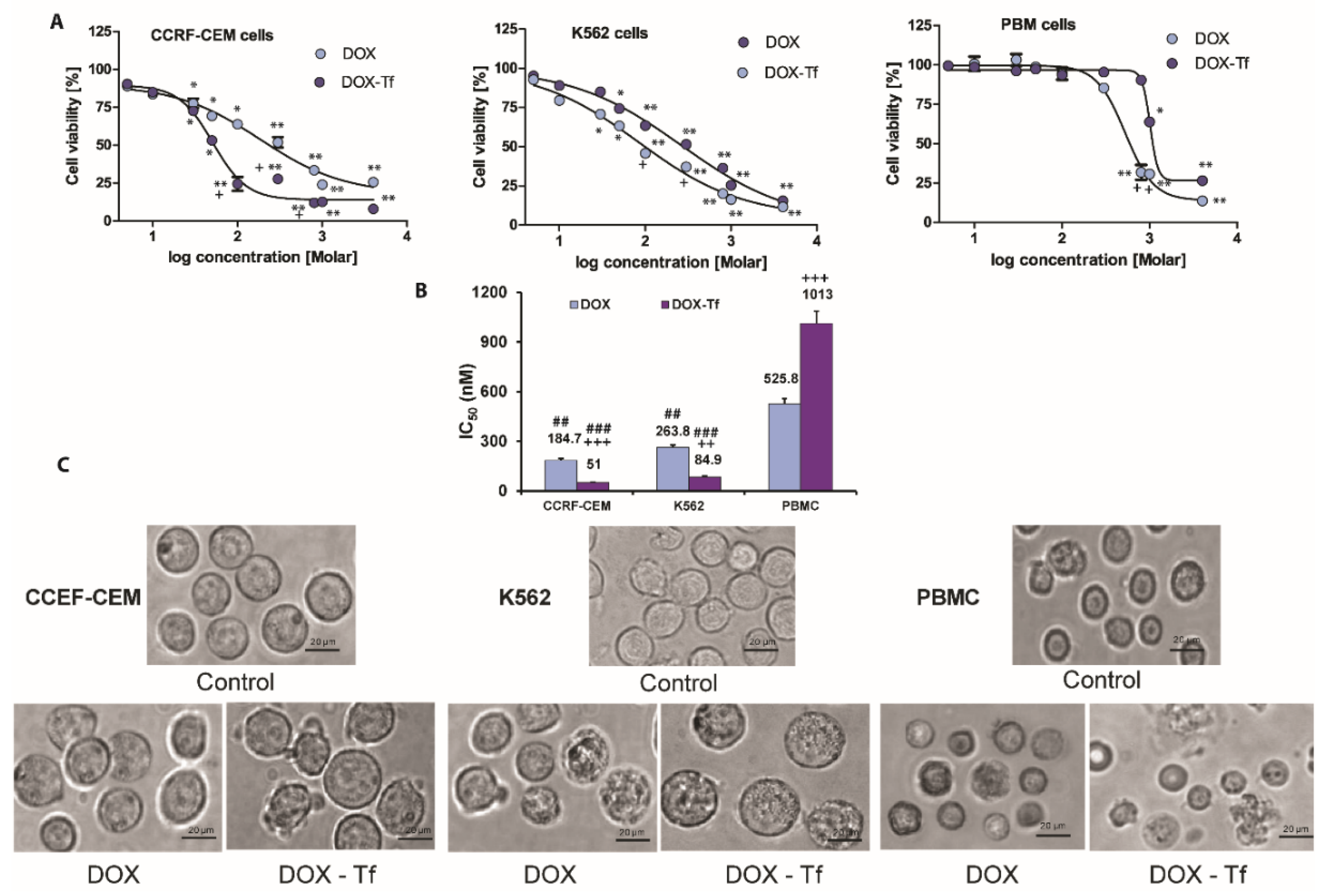
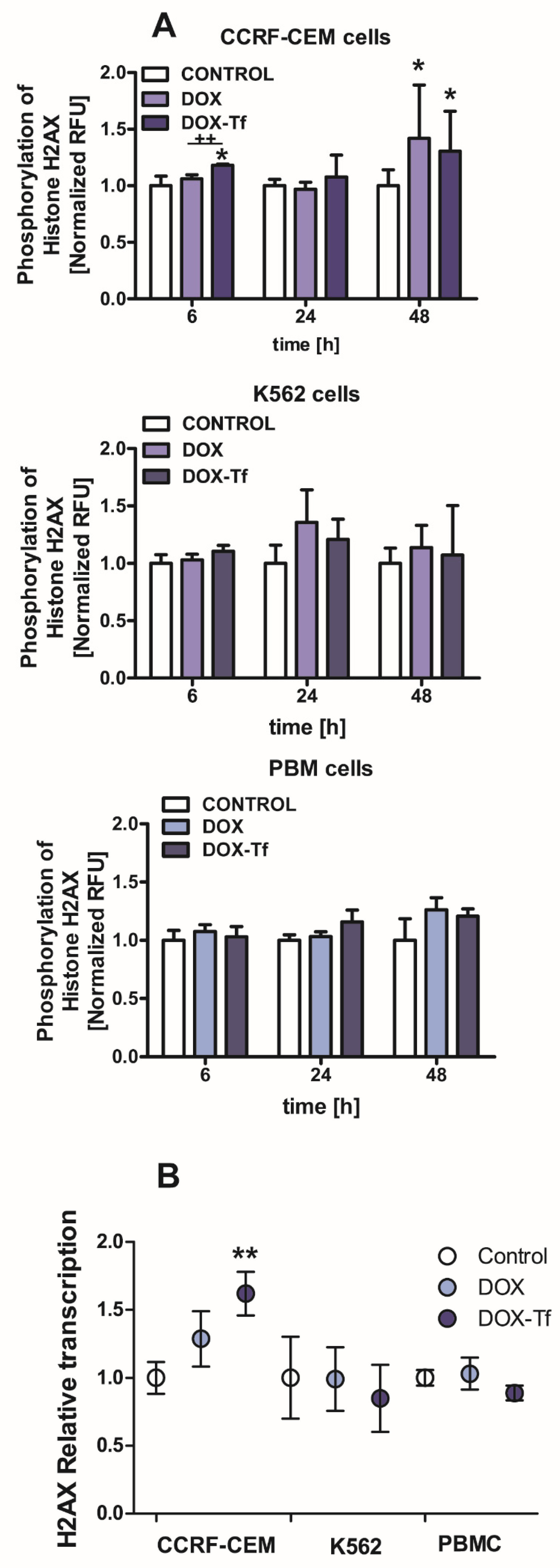
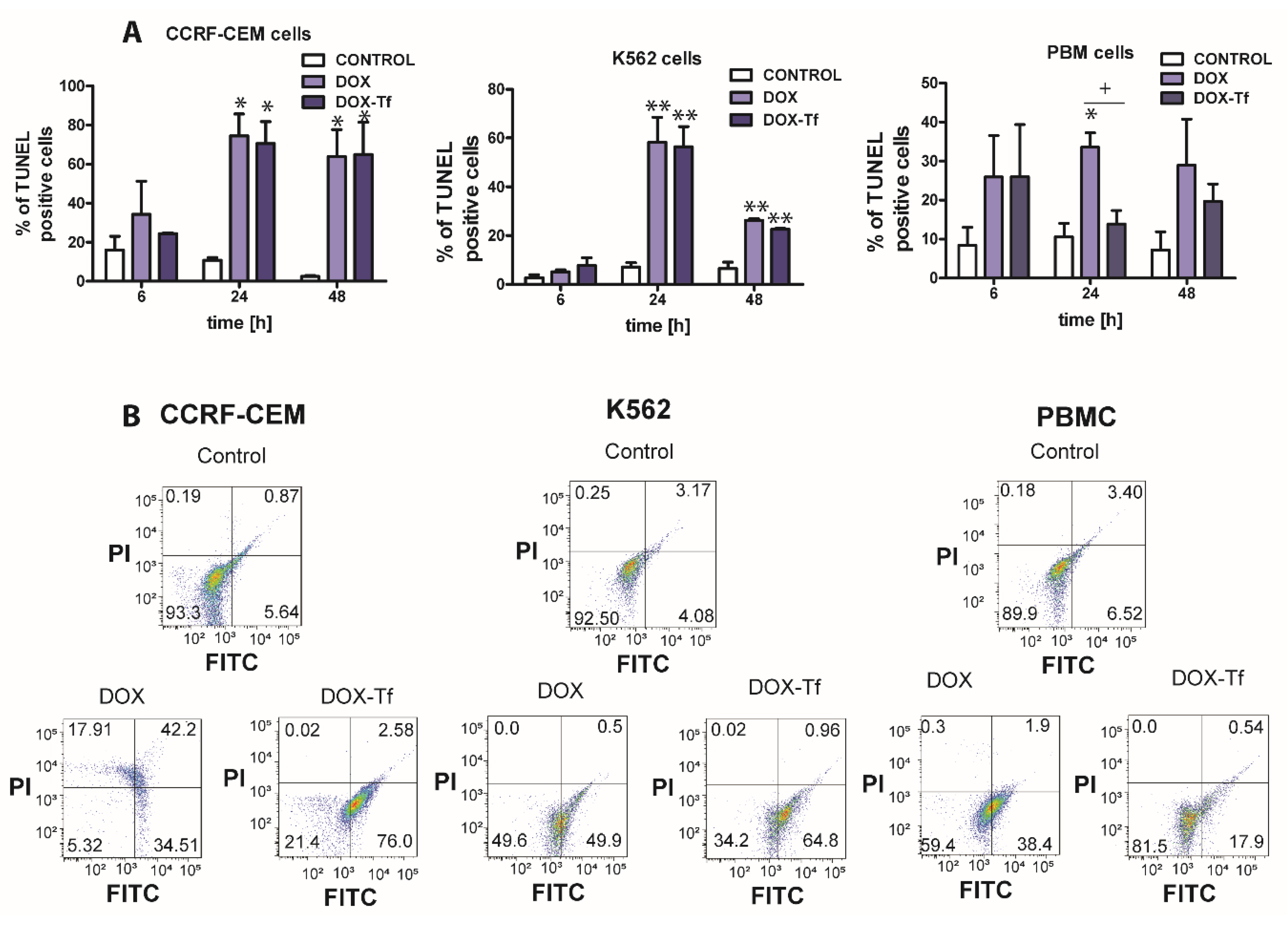


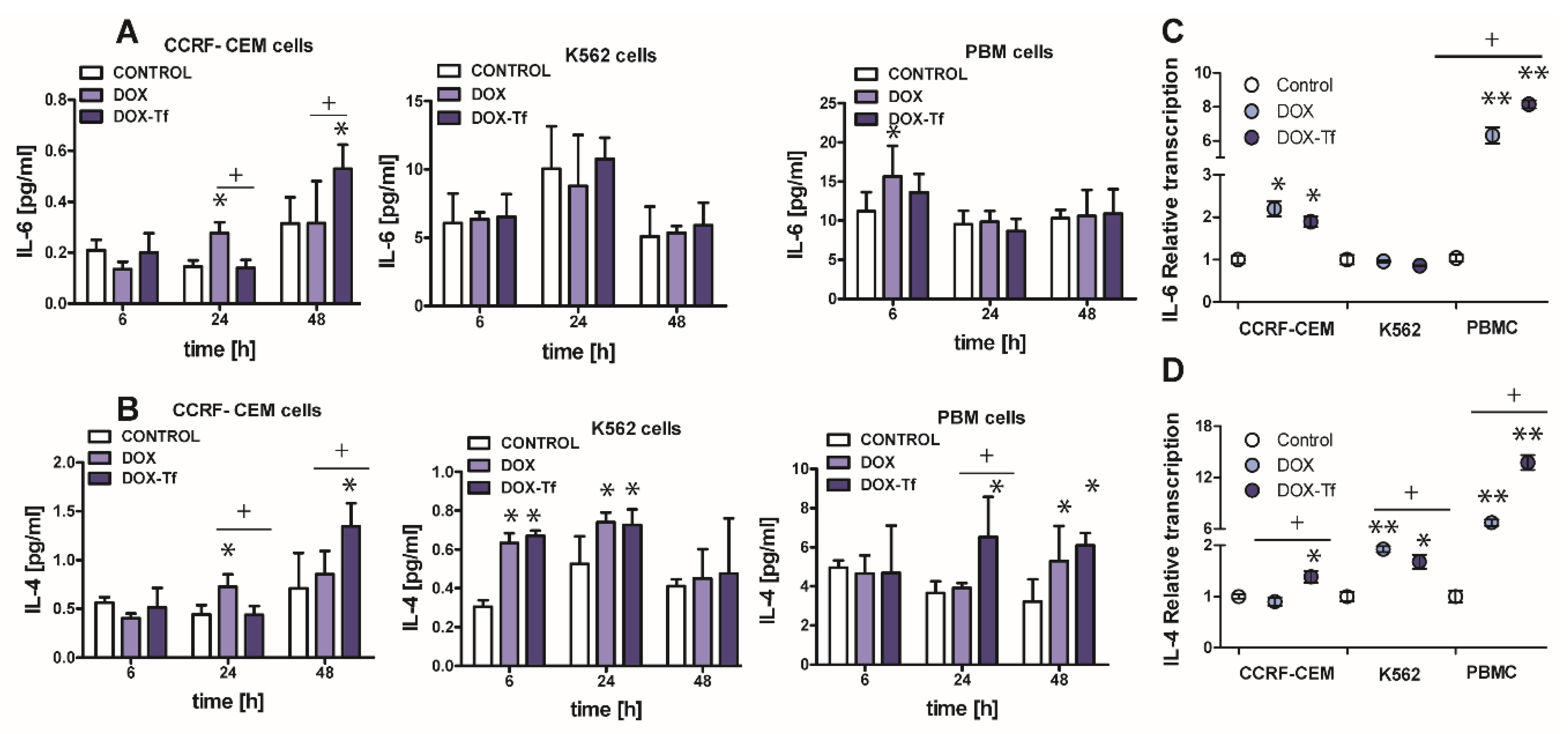
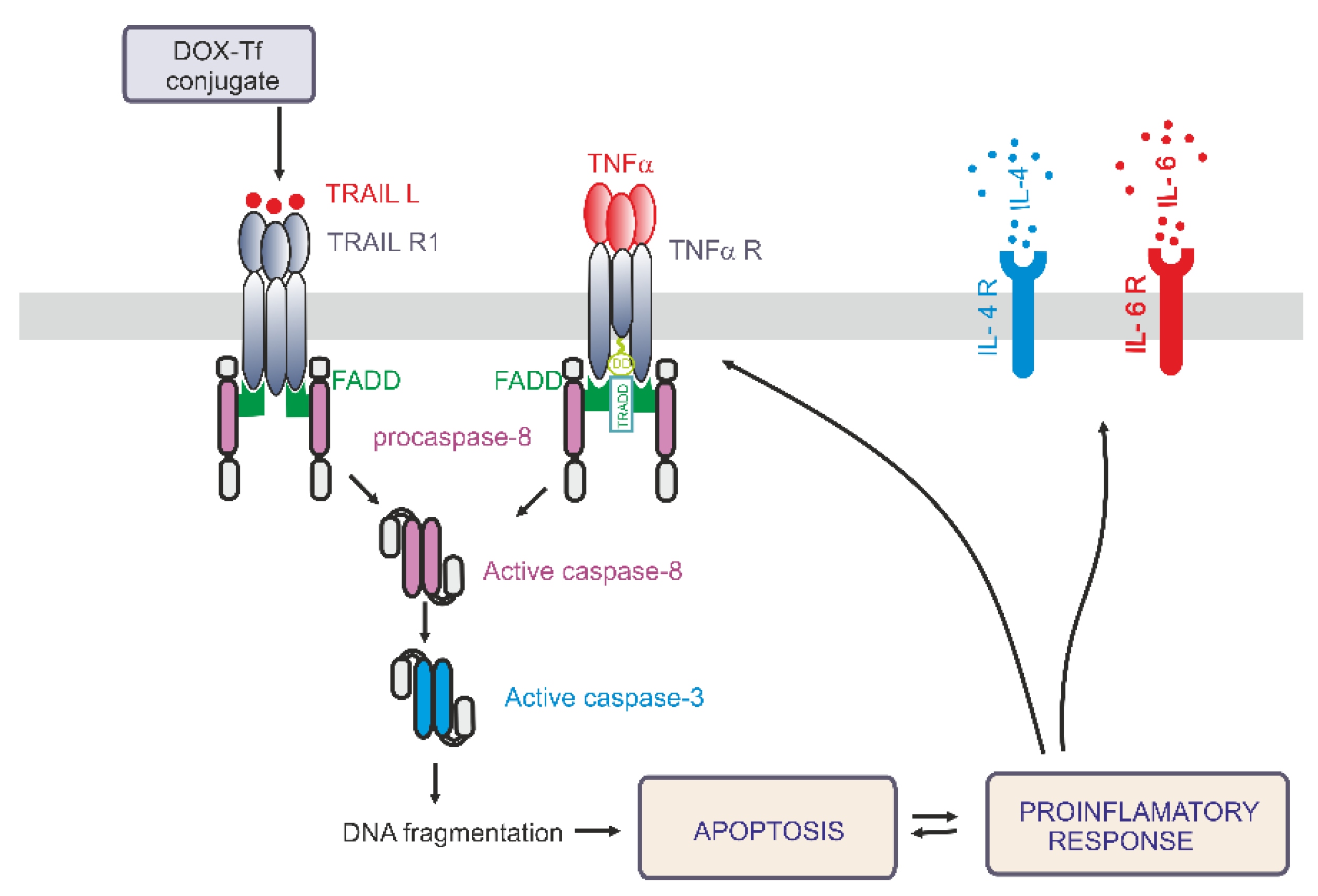
| Gene | Strand | Sequence 5′to 3′ |
|---|---|---|
| Hypoxanthine-guanine Phosphoribosyltransferase (HPRT1) | Forward Reverse | TGACACTGGCAAAACAATGCA GGTCCTTTTCACCAGCAAGCT |
| Hydroxymethylbilane synthase (HMBS) | Forward Reverse | CAAGGACCAGGACATCTTGGAT CCAGACTCCTCCAGTCAGGTACA |
| H2AX | Forward Reverse | GGCCTCCAGTTCCCAGTG TCAGCGGTGAGGTACTCCAG |
| TRAIL-L | Forward Reverse | ACCAACGAGCTGAAGCAGAT CAAGTGCAAGTTGCTCAGGA |
| TNF-α | Forward Reverse | CCCAGGGACCTCTCTCTAATCA GCTACAGGCTTGTCACTCGG |
| IL-4 | Forward Reverse | TTGAACAGCCTCACAGAGCAGA GTTGTGTTCTTGGAGGCAGCA |
| IL-6 | Forward Reverse | TCTCCACAAGCGCCTTCG CTCAGGGCTGAGATGCCG |
Publisher’s Note: MDPI stays neutral with regard to jurisdictional claims in published maps and institutional affiliations. |
© 2020 by the authors. Licensee MDPI, Basel, Switzerland. This article is an open access article distributed under the terms and conditions of the Creative Commons Attribution (CC BY) license (http://creativecommons.org/licenses/by/4.0/).
Share and Cite
Jedrzejczyk, M.; Wisniewska, K.; Kania, K.D.; Marczak, A.; Szwed, M. Transferrin-Bound Doxorubicin Enhances Apoptosis and DNA Damage through the Generation of Pro-Inflammatory Responses in Human Leukemia Cells. Int. J. Mol. Sci. 2020, 21, 9390. https://doi.org/10.3390/ijms21249390
Jedrzejczyk M, Wisniewska K, Kania KD, Marczak A, Szwed M. Transferrin-Bound Doxorubicin Enhances Apoptosis and DNA Damage through the Generation of Pro-Inflammatory Responses in Human Leukemia Cells. International Journal of Molecular Sciences. 2020; 21(24):9390. https://doi.org/10.3390/ijms21249390
Chicago/Turabian StyleJedrzejczyk, Monika, Katarzyna Wisniewska, Katarzyna Dominika Kania, Agnieszka Marczak, and Marzena Szwed. 2020. "Transferrin-Bound Doxorubicin Enhances Apoptosis and DNA Damage through the Generation of Pro-Inflammatory Responses in Human Leukemia Cells" International Journal of Molecular Sciences 21, no. 24: 9390. https://doi.org/10.3390/ijms21249390
APA StyleJedrzejczyk, M., Wisniewska, K., Kania, K. D., Marczak, A., & Szwed, M. (2020). Transferrin-Bound Doxorubicin Enhances Apoptosis and DNA Damage through the Generation of Pro-Inflammatory Responses in Human Leukemia Cells. International Journal of Molecular Sciences, 21(24), 9390. https://doi.org/10.3390/ijms21249390






